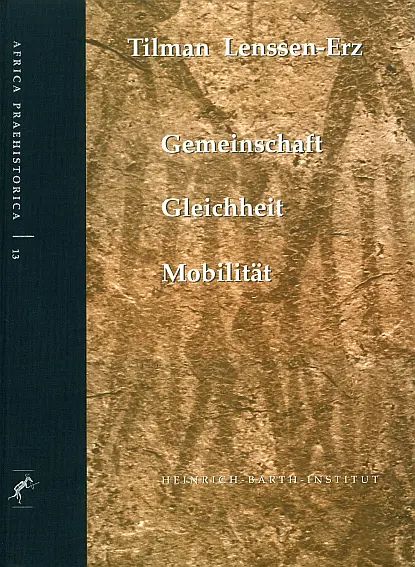- Autor/in:
- Author:
- Tilman Lenssen-Erz
- Erscheinungsjahr:
- Publication year:
- 2001
- Reihe & Band:
- Series & Number:
- Africa Praehistorica 13
- ISBN:
- ISBN:
- 978-3-927688-19-3
- DOI:
- DOI:
- 10.18716/hbi/ap13
- Preis:
- Price:
- 69 € Aktuell: 5 €
- 69 € Discount price: 5 €
Die Felskunst des Brandbergs in Namibia ist einzigartig in Bezug auf den Umfang und die Qualität ihrer Dokumentation und anschließenden Veröffentlichung. Die vorliegende Studie basiert auf den Daten der gesamten Felskunst in einem 135 km² großen Gebiet des südlichen Brandbergs - dem gesamten Korpus der Felskunst aus den ersten drei Bänden von H. Pager "The Rock Paintings of the Upper Brandberg". Diese Studie analysiert 17.000 Figuren, 2.100 Szenen, 1.600 Überlagerungen und 327 Standorte und deckt das gesamte Spektrum der dort anzutreffenden Landschaftstypen vom Fuß des Berges bis zu seinen Gipfeln ab. Diese breite empirische Basis bildet die Grundlage für die neue Methode der textuellen Felskunstarchäologie, die Felskunst als ein Mittel der menschlichen Kommunikation versteht, bei dem kommunikative Äußerungen nur durch eine Matrix von Regeln verständlich werden. Diese Studie befasst sich mit den Grundsätzen der Übermittlung von Botschaften durch Felskunst. Die Methode gibt auch Aufschluss über die Bedeutung, den sozialen Hintergrund und das landschaftliche Umfeld der Felskunstbotschaften und ermöglicht umfassende Interpretationen einer Lebenswelt im Hinblick auf soziale und symbolische Merkmale wie Geschlechterrollen oder die Bedeutung von Tiermotiven. Die grundlegende Botschaft dieser Kunsttradition liegt jedoch in der Darstellung der drei großen Ideale dieser prähistorischen Gesellschaft, nämlich Gemeinschaft, Gleichheit und Mobilität. Außerdem werden hier zum ersten Mal Felszeichnungen von der Südseite des Brandbergs wiedergegeben, die von E.R. Scherz seit den 1960er Jahren dokumentiert wurden.
The rock art of the Brandberg in Namibia is unique in the comprehensiveness and quality of its documentation and subsequent publication. The present study is based upon data from all rock art within a 135 km² area of the southern Brandberg - the whole corpus of rock art from the first three volumes of H. Pager "The Rock Paintings of the Upper Brandberg". This study analyzes 17,000 figures, 2,100 scenes, 1,600 superimpositions and 327 sites, and covers the full spectrum of landscape types encountered there, from the foot of the mountain up to its peaks. This broad empirical base is the foundation of the new method of textual rock art archaeology which understands rock art as a means of human communication in which communicative utterances become comprehensible only through a matrix of rules. This study elaborates on the principles of how messages are conveyed through rock art. The method also provides insight into the meaning, the social background and the landscape setting of the rock art messages, enabling comprehensive interpretations of a life-world in terms of social and symbolic features, such as gender roles or the significance of animal motifs. However, the fundamental message of this art tradition lies in the outline of three major ideals of this prehistoric society, i.e. community, equality and mobility. In addition, rock paintings from the south side of the Brandberg, documented by E.R. Scherz from the 1960s on, are reproduced here for the first time.

